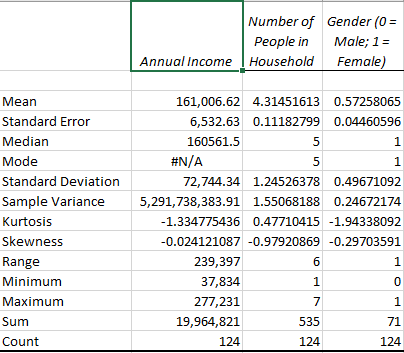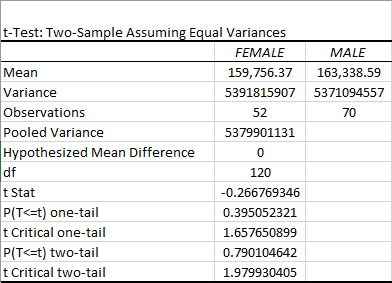Introduction
This report concerns an analysis performed for Loving Organic Foods by Diligent Consulting Group. Its main objective is to establish the idea behind the motivation of buying habits of the customers. The information provided was incomplete and so it was necessary to recontact the customers who had earlier participated in the data collection process. The aim of reaching out to the customers again was to assist in the collection of additional data. After acquiring the additional information, the database was made up of the annual amount spent on organic food, annual income, age, gender, and the number of people in the household. It is important for Loving Organic Foods to appropriately utilize the data in establishing better understanding of the buying trends of buyers in the market.
Organic Food Industry Description
The purchase and consumption of organic products are increasing since the production methods utilize the appropriate farming standards. The development of organic food markets entails the creation of benefits for the producers because their production avails higher income for the commodities they produce for sustainability (Bazaluk et al., 2020). The realization of co-existence requires the harmonization of the business plans and adhering to the International Federation of Organic Agriculture Movements (IFOAM) legislation standards (Meemken & Qaim, 2018). Similarly, sustainability issues are achieved through the consolidation of organic agricultural laws which are capable of the facilitation of the international market and trade developments (Bostan et al., 2019). There exists a strong association between the production capacity of organic products and the sustainable implementation of development goals (Bazaluk et al., 2020). Sustainability of the organic products ensures the problem of inadequacy is avoided.
The production of organic products incorporates a method of farming which uses little chemicals, unlike the conventional methods. Consumers perceive these foods to be healthier and nutritious in comparison to other foods. This is attributed to the lower contamination levels in them (Meemken & Qaim, 2018). Therefore, consumers purchase organic edibles because of the attached health benefits obtained from the products. Additionally, their production is believed to cause little environmental effect as compared to conventional agricultural methods. This has made many governments to subsidize the organic agricultural sector (Meemken & Qaim, 2018). Many consumers of these products prefer to purchase them since they are environmentally friendly.
The target market for organic foods products is found globally. The characteristics of the global market are varied due to the size of the market. Demographically, it consists of different age groups although the adults and the older people are the ones who are mostly conscious of their diets. The market has people with different lifestyles, although much focus will be on those who prefer a health lifestyle and have shopping behaviors inclined towards organic foods. The organic product market refers to an economic venture creating appropriate standards for selling the farm products such as food products within a designated and an equipped location as per the stipulated regulations (Bazaluk et al., 2020). 181 countries form the global participants engaged in the international trade market which is worth $97 billion as of 2017 (Bazaluk et al., 2020). The US forms the largest market of organic foods at 43% (Bazaluk et al., 2020). The consumers purchasing the organic products are attached to the health benefits, friendliness to the environment and the farming practices which utilize little chemical in their production
Results
From the conduction of descriptive statistics, the results in Table 1 were obtained.

From the conducted two-sample test assuming equal variance, the results in Table 2 were obtained:

Analysis
The analysis required the use of Microsoft Excel to analyze the data set as shown above in Table 1. The performed analysis generated descriptive statistics for the new variables. The variables included the gender of the customers, the number of people in the household, and the annual income. The descriptive statistics give information for the, mean, standard error, median, mode, standard deviation, sample variance, kurtosis, skewness, range, minimum, maximum, sum, and count as illustrated in Table 1 above.
The second section of the analysis entailed the investigation of the client’s claim through the use of MS Excel. The applicable technique was the two-sample test assuming equal variance since the standard deviation of the population is not known. According to his/her claim, the amount of money spent on the purchase of organic foods is similar for both male and female customers. Testing this claim applied a significance level of alpha equal to 0.05. The claim is tested after formulating the hypothesis under investigation. The formulated hypothesis is in two forms: the null and the alternative.
- The Null Hypothesis: H0: There is no significance difference between the amount of money spent on the purchase of organic foods for the female and the male.
- The Alternative Hypothesis: H1: There is a significance difference between the amount of money spent on the purchase of organic foods for the female and the male.
Discussion
From standard errors, there exists a significant difference between the obtained hypothesized and the sample mean values. The skewness of the annual income, the number of people in a household and gender possess negative values. The negative skewness values are an indication of a long tail of the data falling on the left, therefore, the model and the median exceed the mean. The higher variance in the annual income indicates there exists more dispersion away from the mean. The lower variance in the number of people in a household and gender is an indication of little dispersion from the mean. The low negative kurtosis values in the two categories are an indication of the existence of a flat platykurtic distribution while the positive kurtosis is an indication of a tall leptokurtic distribution. Similarly, the descriptive statistics availed information about the mean, mode, count, sum, maximum and minimum values for each category.
Recommendations
From the analysis, the main consumers of organic products are the high-income earners. Loving Organic Foods should prioritize more on meeting their demands to expand their market segment and boost sales for profit maximization. Similarly, variation in the spending among the genders creates a market gap which needs to be exploited to ensure those spending more on the products are tapped. Considering the recommendations will expand the distribution base resulting in greater access to the target market.
Comment: The recommendations differ since in this case, more advanced analysis techniques were applied which resulted in the achievement of a more exhaustive and inclusive analysis.
Conclusion
From the two-sample test assuming equal variance technique analysis, it is important to reject the null hypothesis. Therefore, it is statistically correct to consider the alternative claiming there is significant difference between the amount of money spent on the purchase of organic foods for the female and the male. This is because the computed p-value, 0.79 is greater than the p-value, 0.05. Therefore, the client’s claim suggesting an existing similarity in the amount of money spent on the purchase of organic foods for both male and female customers is false. In conclusion, there exists a statistically significant difference between the amount of money spent on the purchase of organic foods for the female and the male.
References
Bazaluk, O., Yatsenko, O., Zakharchuk, O., Ovcharenko, A., Khrystenko, O., & Nitsenko, V. (2020). Dynamic development of the global organic food market and opportunities for Ukraine. Sustainability, 12(17), 6963. doi:10.3390/su12176963
Bostan, I., Onofrei, M., Gavriluţă (Vatamanu), A. F., Toderașcu, C., & Lazăr, C. M. (2019). An integrated approach to current trends in organic food in the EU. Foods, 8(5), 144. doi:10.3390/foods8050144
Meemken, E., & Qaim, M. (2018). Organic agriculture, food security, and the environment. Annual Review of Resource Economics, 10(1), 39-63. doi:10.1146/annurev-resource-100517-023252